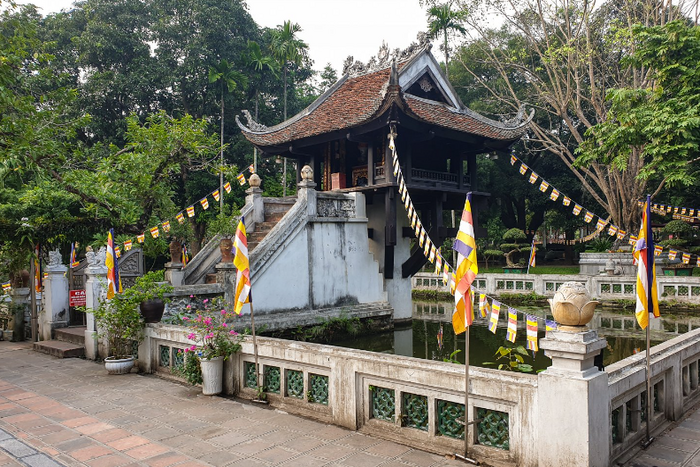Towering above the bustling streets of Hanoi, One Pillar Pagoda stands as a testament to Vietnamese ingenuity and faith. Recognized as the most unique architectural pagoda in Vietnam, it beckons visitors with its captivating design and rich history. Let Autour Asia guide you through this enriching journey to gain more useful information for your upcoming trip to Vietnam.
I. Introduction General of One Pillar Pagoda
1. Location
Nestled within the bustling heart of
Hanoi,
One Pillar Pagoda known as Dien Huu Pagoda or Mật Pagoda, stands as a graceful testament to the city's rich history and cultural heritage. Situated in the Ba Dinh district, this pagoda offers a unique architectural experience and a peaceful escape from the city's vibrant energy. Its central location places it within easy walking distance of several other major attractions of the capital. This proximity makes it convenient to combine a visit to the pagoda with other sightseeing in the city.
2. Legend of the One Pillar Pagoda
Hanoi One Pillar Pagoda is more than just a stunning architectural marvel. It's a symbol of hope, gratitude, and faith, its origins intertwined with a beautiful legend. The story begins with Emperor Ly Thai Tong, who ruled Vietnam from 1028 to 1054. Despite a prosperous reign, his heart was heavy with a deep sadness - he had no heir to carry on his legacy. One night, the emperor had a strange dream. He found himself standing on the surface of a tranquil lake when a magnificent lotus flower rose from the water. Atop the blossom sat a beautiful woman, radiant and serene, holding a baby in her arms. The woman, identified as bodhisattva Avalokitesvara, (Quan Thế Âm Bồ Tát), the Goddess of Mercy, presented the child to the emperor, assuring him that he would be his heir.
When he woke up, the emperor was filled with surprise and some joy. He immediately told the story to the court officials and monk Thien Tue, who interpreted the dream as a divine auspicious omen and advised the king to build a pagoda. From there, the most unique architectural pagoda built on a pillar rising out of the water, reflecting the lotus flower in his dream, appeared as an expression of his gratitude to Bodhisattva Avalokiteshvara.
3. The One Pillar Pagoda through the history
Built in 1049, the One Pillar Pagoda served as a haven for the emperor, offering a space for both worship and meditation. Its unique design, a single wooden pillar supporting a lotus-shaped platform, embodies the core tenets of Buddhist teachings: purity and serenity. Over the centuries, the pillar pagoda has weathered numerous storms. Destroyed by fire in 1615, it rose again under the Nguyen Dynasty in 1649. During the French colonial period (1884 - 1945), the French forces sought to demolish it, the pagoda faced neglect and relocation, and its land was confiscated for the military. Yet, despite these hardships, the One Pillar Pagoda persevered, standing as a testament to Hanoi's resilience and enduring cultural heritage.

After the war, the Vietnamese government embarked on a painstaking reconstruction project, using both salvaged materials and reinforced concrete to meticulously restore the pagoda. This process, begun in 1955, aimed to preserve the original design and honor the pagoda's rich history. In 1958, the Hanoi pagoda reopened its doors to the public, reborn as a symbol of Vietnam's enduring spirit and unwavering commitment to its heritage. The Asian Record Organization recognised this architectural work as the most unique architectural pagoda in Asia in 2012. Today, the One Pillar Pagoda beckons visitors worldwide with its intricate architecture, peaceful grounds, and captivating legend. Stepping through its gates, you embark on a journey through a thousand years, experiencing the enduring power of faith, tradition, and cultural heritage.
II. The unique architecture of this pagoda
1. Lotus Station ( Đài Liên Hoa)
The Pillar Pagoda's architecture is a mesmerizing blend of yin and yang. A square stone pillar represents yin, balanced by the round stone symbolizing yang, echoing the universe's harmony. Eight wooden beams, forming eight flower petals, support the structure, their perfect alignment ensuring its remarkable sturdiness. Situated on a large stone pillar, the pagoda resembles a lotus flower blooming in the center of Linh Chieu Lake. Red scale tiles adorn the curved roof, accentuated by an exquisitely carved sculpture of "lưỡng long chầu nguyệt" (two dragons flanking the moon). This image represents cosmic harmony and safeguards the pagoda's sanctity. The One Pillar Pagoda is a masterpiece, seamlessly blending architectural brilliance, artistic painting, and intricate stone sculptures.
The Lotus Station, a square structure with sides of 3 meters, stands within a protective fence. Military columns and large wooden beams, meticulously joined to the stone pillar, provide support. The interior boasts a splendid altar, adorned with a gilded statue of Guan Yin, the thousand-armed, thousand-eyed deity. Exquisite porcelain vases, cups, and incense burners accompany the altar, painted with gilded vermilion and adorned with beautiful cloud motifs. On the innermost ceiling, a small panel proclaims "Lien Hoa Dai" in golden characters on a red background, completing the pagoda's mesmerizing narrative.
2. Tam Quan Gate
In the grounds of One Pillar Pagoda, there is Tam Quan Gate, also known as Tam Môn, which is the first place which visitors set foot on a visit to One Pillar Pagoda, with a horizontal panel engraved with the three words "Diên Hựu Tự".( Dien Huu pagoda). This gate was originally built many years ago but was recently rebuilt to expand the scale of the pillar pagoda, creating a place for religious activities for monks and nuns as well as welcoming tourists.
This majestic gate is placed in front of the pagoda in a very delicate way, helping to simulate the a traditional Vietnamese architecture of the pagoda, with 2 floors and 3 aisles. Tam Mon Gate has an important meaning, symbolizing the concept of "three ways of seeing" of Buddhism, including: “hữu quan”, “không quan” and “trung quan”.
III. Complete guide for your visit to this One Pillar Pagoda
1. The best time to visit
The Hanoi One Pillar Pagoda, one of
the best pagodas in Vietnam, welcomes visitors with its unique architecture and tranquil atmosphere every day from 8:00 am to 6:00 pm. This architectural marvel offers a unique opportunity to experience Vietnamese culture and tradition. Twice every lunar month, on the first and fifteenth day, the worship ritual will be held at the inner building. When planning your visit during these occasions, you can observe a common, yet impressive tradition of Vietnamese people: worshipping toward gods and ancestors.
2. How to get there?
To reach this spiritual destination, visitors can choose many different means of transportation to One Pillar Pagoda in Hanoi :
a. Taxi or motorbikes
If traveling by personal vehicle, you can find your way based on Google Maps. If you don't want to find your way, you can call a taxi or Grab to be picked up.
For quick and convenient transportation, consider motorbike taxis or taxis. Motorbike taxis (xe ôm) are widely available and offer affordable rides. Taxis provide a comfortable travel experience.
Grab App: Book taxis seamlessly using the Grab app, similar to Uber. Install the app, create an account, and enjoy easy bookings.
SM Green Electric Taxi: Opt for an eco-friendly SM Green Electric Taxi. Install their app or call (+84) 19002088 for a ride. Their fares are relatively cheaper than other taxi services in Vietnam...
b. Bus
Hanoi boasts a well-connected network of buses and green electric buses, providing comprehensive coverage throughout the city.. The bus route passing through One Pillar Pagoda is route number 09ACT, 09A, 18,... all of which stop at 15A Le Hong Phong, then walk about 200m to reach this pagoda
3. One Pillar Pagoda entrance fee
For Vietnamese citizens visiting the One Pillar Pagoda, you will get free admission while the One Pillar Pagoda entrance fee for foreign tourists is only 25,000 VND (approximately $1). This modest contribution helps maintain this cultural treasure and ensures its continued preservation for future generations.
4. Tips on visiting to Hanoi One Pillar Pagoda
Be mindful of your behavior as it is a place of worship. Photography is allowed, but be respectful of other visitors and avoid using flash photography inside the pagoda.
Dress code: As a place of worship, respectful attire is appreciated. Cover your shoulders and knees, and avoid wearing revealing clothing.
Combine your visit with other nearby attractions: The One Pillar Pagoda is located close to the Ho Chi Minh Mausoleum, the Presidential Palace, and the Hoa Lo Prison Museum… You can easily combine your visit to the pagoda with other sightseeing activities.
This captivating landmark offers visitors a chance to experience the rich history and spiritual heritage of Vietnam. So, if you find yourself in Hanoi, be sure to pay a visit to the One Pillar Pagoda, a place where legend and faith intertwine to create a truly unique and unforgettable experience.
For more information or to have an even more wonderful experience, don't hesitate to
CONTACT US now.





























